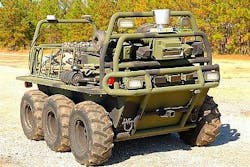Lockheed Martin demonstrates remote satellite control of UGV in battlefield conditions
GRAND PRAIRIE, Texas, 23 Feb. 2013. Unmanned vehicles experts at the Lockheed Martin Corp. Missiles and Fire Control segment in Grand Prairie, Texas, have shown they can control an unmanned ground vehicle (UGV) remotely via satellite in battlefield conditions.
Lockheed Martin experts demonstrated the company's Squad Mission Support System (SMSS) UGV at the Camp Grayling National Guard training base in Northern Michigan, under satellite control by UGV technicians at the Army's Tank Automotive Research, Development and Engineering Center (ARDEC) near Detroit more than 200 miles away, company officials say.
The SMSS, an independent research and development project by Lockheed Martin, is a six-wheeled unmanned all-terrain vehicle (ATV) designed to provide manned and unmanned transport and logistical support to Army and Marine Corps light and early entry forces.
The SMSS is an unmanned squad-size vehicle for carrying food, equipment, and wounded infantrymen. The unmanned ATV weighs 3,800 pounds, can carry as much as 1,200 pounds, and has a range of 125 miles.
The SMSS, which comes in transport, scout, mobile power, and mobile communications variants, can be carried inside CH-47 and CH-53 military helicopters, or can be sling carried by a UH-60 helicopter.
During the Grayling, Mich., tests, the SMSS vehicle conducted several battlefield surveillance operations while being controlled beyond line-of-sight via satellite from Army ARDEC in Warren, Mich.
The demonstration proved that the combination of autonomy, vehicle mobility, surveillance sensors, and satellite communications can provide a means of battlefield situational awareness while keeping soldiers out of harm's way, Lockheed Martin officials say.
During the demonstration, SMSS was equipped with a Gyrocam 9M tactical surveillance sensor and a General Dynamics SATCOM-on-the-move system. The unmanned ATV had an adjustable-height mast with the Gyrocam 9M, acquiring high-resolution electro-optical and thermal video while on-the-move.
Technicians at the Army ARDEC controlled the SMSS movement and sensor functions via satellite. In another simulated mission, the remote operator provided a pre-planned route and SMSS autonomy enabled navigation with minimal operator intervention. Tests also demonstrated the SMSS follow-me, go-to-point, and retro-traverse autonomous functions.
For more information contact Lockheed Martin Missiles and Fire Control online at www.lockheedmartin.com/us/mfc, Army ARDEC at www.ardec.army.mil, or Camp Grayling at http://grayling-mi.com/attractions/historical-sites-2/camp-grayling-military-installation.
